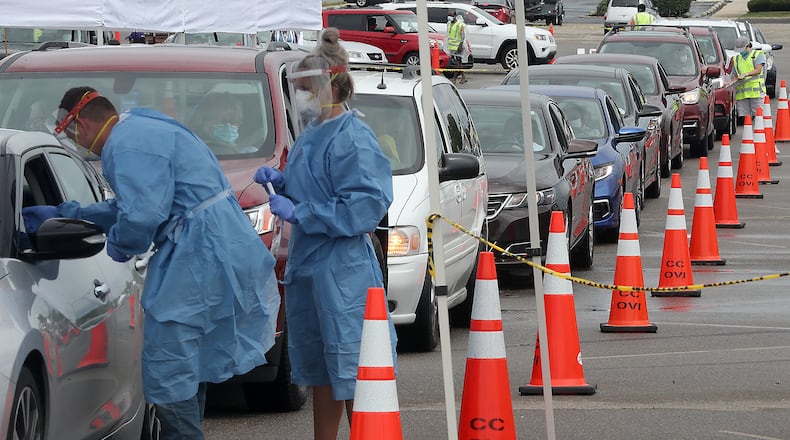Where are we at with testing capacity?
The state overall has reported significant expansion in testing in Ohio, with test counts climbing throughout the summer. The state reported 22,834 daily tests on Sept. 6, according to a preliminary count by the Ohio Department of Health.
Some of those tests are because many hospitals in Ohio adopted policies of patients getting tested prior to surgery.
Ohio is also working on other testing strategies, such as a pending group purchasing effort with six other states to buy quick tests for faster screening. The state also just started a testing program to monitor sewage for coronavirus fragments, because wastewater data can be an early sign of a surge.
About 4.3% of tests reported over the past week came back positive in Ohio, though the rate of positive tests varies in different parts of the state. The percent positive rate is an indication of whether the level of testing is keeping up with the level of disease spreading in the community. The World Health Organization had recommended a rate below 5% as a good threshold.
How long does it take to get results?
The tests are less useful if results take a long time to come back, and the time it takes to get results differs among labs and test sites.
CVS reported most of its tests take two to three days to turn around.
Premier Health and its lab business partner CompuNet recently reported expanded capacity to essentially eliminate their backlog. If you call ahead to a test site, they should be able to tell you their average turnaround time.
Who can get a test?
Some testing sites require an appointment, doctor’s note or symptoms. Others will test anyone.
The best way to find out the requirements is to call the testing site, or your primary care provider can also advise you. Many of the testing sites are listed at coronavirus.ohio.gov.
The pop-up sites that are free and open to everyone — with or without a doctor’s note or symptoms — have encouraged people to get tested who have symptoms, recent exposure to someone infected by the coronavirus or with a lot of recent exposure to others or to crowds.
Stephen Roller, Primary Health Solutions chief clinical officer, said in October it will shift to coronavirus testing based out of it Express Care locations, with testing essentially for symptomatic people. He said the decision to focus on symptomatic patients was made “in collaboration with the health commissioners and seeing what was going on in our communities and how we can be a good steward of our testing and human resources.”
Roller said people who get tested should quarantine until they get their results. If they don’t quarantine and then test positive, they could infect more people while awaiting results. If they get a negative result, that might not mean much if they have been out having more social contact while waiting for a result.
When should you get tested?
There’s also an incubation period after a person has been exposed when it could be too early to test. For example, if a person learns they spent close time with someone who has COVID-19, Dr. Sherman Alter, chief of the division of infectious disease at Dayton Children’s Hospital, said it’s best to wait five to seven days after you were exposed before getting tested.
“If you do it too early, in that first sort-of-week after the significant exposure, your test may be falsely negative because you did not establish the infection yet,” Alter said.
If you’ve tested positive, you probably don’t need tested again, except for some rare circumstances. If you’re at least 10 days out from the onset of illness, not sick and not using anything to reduce a fever, you’re considered noninfectious.
“After a couple of weeks, our body is no longer able to transmit the infection to another person, but that person may still test positive and the reason is that the PCR (test) is so sensitive, it can pick up non-viable virus,” Alter said.
What about kids and coronavirus tests?
Some testing sites might not offer tests to young patients, but the guidelines for who should get a test are basically the same as for adults.
Dr. Hector Wong, interim chair of pediatrics and chief medical officer at Cincinnati Children’s, said in general his hospital is testing kids who are symptomatic. Many institutions will test children prior to surgical procedures. At times a child also might be tested because of a close contact with somebody who is positive for the coronavirus, Wong said.
If a particular site does not offer testing for children, he said that likely reflects being uncomfortable dealing with little people. A young patient with symptoms might not want a nasal swab, so Wong said “it might be useful to have personnel who are more accustomed to working with children.”
Should I get an antibody test?
Antibody tests indicate whether someone recovered from a COVID-19 infection. At this point, they are more useful for research than for personal health information.
Research continues into how long people have protective immunity after recovering from an infection, so people who get positive antibody tests are still advised to take precautions like wearing a mask and keeping social distance. Researchers are performing some random surveys involving volunteers getting antibody tests, which can help show if the virus has spread. Some plasma centers are also seeking donations from people with positive antibody tests.
About the Author
